Earwigs, those peculiar-looking insects with distinctive pincers on their abdomens, have long been the subject of myths and misconceptions. One of the common misunderstandings about earwigs is the belief that they bite humans. In this article, we will delve into the truth behind earwig bites, exploring their anatomy, behavior, and whether they pose a threat to humans.
Read more about Baby Rats
Contents
Anatomy of the Earwig
Earwigs belong to the order Dermaptera and are characterized by their elongated bodies, membranous wings folded beneath short forewings, and the forceps-like cerci at the end of their abdomens. These cerci, often mistaken for a stinger or pincers, are used by earwigs for various purposes, including mating rituals and defense mechanisms.
Despite their fearsome appearance, earwigs are generally harmless to humans. They are omnivores, feeding on a variety of organic matter such as decaying plant material, insects, and sometimes smaller arthropods. Their preference for damp and dark environments makes them commonly found in gardens, mulch, and under stones.

Dispelling the Myth: Do Earwig Bite?
The notion that earwigs bite humans is a persistent myth that has been perpetuated for generations. However, it is crucial to clarify that earwigs are not aggressive toward humans and do not seek to bite. Their primary defense mechanism is the use of their cerci to grasp and deter potential predators.
In rare instances, an earwig might use its cerci defensively when it feels threatened, such as when handled. While this can result in a mild pinch, it is not a true bite. The sensation is more comparable to a pinch rather than the painful bite associated with some other insects.
Understanding Earwig Behavior
To further understand earwig behavior and minimize any potential interactions, it is essential to recognize their habits. Earwigs are nocturnal creatures, typically active during the night, and spend their days in concealed, sheltered locations. They are attracted to moisture and can often be found in areas with high humidity.
Gardeners may encounter earwigs in outdoor settings, particularly in gardens or flower beds. While they may nibble on plants, the damage they cause is generally minimal and rarely warrants intervention. Employing natural pest control methods, such as maintaining a balanced garden ecosystem, can help keep earwig populations in check without resorting to chemical solutions.
Preventing Earwig Encounters
For those concerned about potential earwig encounters, several preventive measures can be taken. Reducing excess moisture around the home and sealing entry points can discourage earwigs from seeking shelter indoors. Additionally, keeping outdoor spaces well-maintained, removing debris, and practicing good garden hygiene can help minimize their presence.
It’s important to note that earwigs are not vectors for diseases and are not known to transmit any harmful pathogens to humans. While their appearance may be unsettling to some, understanding their behavior and biology can alleviate unnecessary fears.
Conclusion
The myth of earwig bites is largely unfounded. Earwigs are not aggressive toward humans, and instances of them causing harm are rare. Their cerci, often mistaken for a dangerous stinger, are primarily used for defense and mating rituals within their own species.
To coexist peacefully with earwigs, it is crucial to dispel misconceptions, understand their behavior, and adopt preventive measures to minimize encounters. By respecting the natural role of earwigs in the ecosystem and recognizing their limited impact on humans, we can appreciate these fascinating insects without unnecessary fear.




[…] Read more about Earwig Bites […]